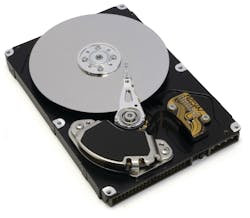Go Easy on Your Hard Drives
Today’s video surveillance systems have substantial workloads and often operate at all times. With constant operational strain and large amounts of critical data involved, design practices to improve system reliability are always a good investment.
Many modern video surveillance systems rely on hard drives as the storage medium for video capture. Hard drives used in these systems are the only major electro-mechanical element in an otherwise solid-state device; therefore, special consideration should be given to the best practices for hard drive installation into a video surveillance unit.
According to IMS Research, the digital storage capacity of the global surveillance marketplace will reach approximately 3.2 billion gigabytes in the year 2013. With such vast amounts of surveillance data, reliable storage solutions are an absolute necessity.
In addition to choosing a storage product that is designed for its specific workload and data category, it is crucial to implement smart and strategic practices for hard drive integration and operation. By thoroughly evaluating the effects of vibration and shock on the storage system, developing a proper mount design to protect it from such forces and following proper thermal management procedures, you can ensure optimal performance and reliability from your storage solution for years to come.
Performance Degradation Due to Vibration and Shock
A hard drive within a surveillance system can experience several types of vibration: translational, which occurs along the x, y or z axis of the drive; multi-axial, which takes place along multiple axes at once; and rotational, a twisting or spinning motion about an axis.
Hard drives are most sensitive to rotational energy that occurs about the motor spin axis (z axis), which is perpendicular to the top cover of the drive. Therefore, rotational vibration (RV) can be a significant issue for hard disk drives, which frequently create this type of energy themselves during operation. Significant reductions in hard drive performance — sometimes more than 50 percent — can result from RV, which is typically generated by the drive’s self-excitations due to seek activity; additional components within the chassis, including other drives, fans or CD-ROMS; and external forces.
The shock environment is described using three primary components: pulse shock, which represents accelerations or displacements; velocity shock, which deals with a sudden change in velocity, as when a falling object hits the ground; and the shock response spectrum, which describes how a system responds to a shock event.
Because shock often disrupts many of the natural frequencies within a storage system, it can cause numerous failures, including permanent deformation, loosened hardware and component-to-component impacts. According to Michael Staiano, an engineer with Seagate Technology, most shock damage to hard drives occurs during installation. Protecting your drive prior to installation and while it is outside the operating environment is paramount to extending the life of the drive and enhancing its reliability.
Proper Mounting
Staiano says a best-case mount is typically a rigid mount that holds the drive symmetrically using the side mounting holes, which minimizes RV energy.
Though many consumer digital recording systems use isolation-mount designs for storage integration, surveillance configurations typically work well with more rigid mounts. Isolators are often used to improve acoustics in a video recording infrastructure, but most surveillance systems do not have extensive acoustic needs like those found in consumer digital recording systems.
Hard-mount designs not only hold the disk drive rigid to reduce RV energy, they also provide a more economical means of integrating hard drives into a surveillance configuration. Isolators can be an unnecessary added cost and can actually intensify vibration issues in certain situations.
Because hard drives in surveillance systems can experience high seek activity as the drive handles numerous video streams, the mount should be as rigid as possible to hold the drive firmly in place. This rule applies to a variety of surveillance architectures — from embedded DVR configurations commonly used in convenience stores, to centralized storage designs, where rack-mount storage and storage enclosures with high drive counts are common. Whatever the configuration, the drive (or drives) should be held secure in the carrier or the chassis to support the high-seek workloads in today’s increasingly sophisticated surveillance systems.
For surveillance designs used in high-shock environments, such as law enforcement and military vehicles, isolation becomes an important factor for reliability and performance. In these cases, both shock and vibration are key issues, and the mount design must account for internal excitation sources, in addition to external forces.
When shock is the primary concern, there are certain guidelines to keep in mind for isolated-mount designs. Because secondary shock is more detrimental to hard disk drives than the initial shock event, good clearance or sway space around the drive is vital, and the isolators must include reliable damping properties.
Even if shock is the main issue, an isolation design cannot dismiss the potential for diminished performance from vibration. Poorly designed isolation systems can intensify vibration at certain frequencies, resulting in lower throughput performance and potential contact among chassis components.
Thermal Management
Your storage solution might not be exposed to traumatic shock events or excessive excitation sources. It might even be held securely within the appropriate mount design. But none of this will matter if the drive is not cooled effectively.
Hard drive performance and reliability are highly dependent on proper thermal management practices within the operating environment.
Hard drives have two categories of specified operating temperatures: the maximum ambient temperature (for example, 0°C to 60°C), which refers to the environment surrounding the disk drive; and the maximum base plate temperature (for example, 69°C). The base plate temperature is the more important parameter and is used to characterize drive operating temperature at given ambient conditions. When the base plate temperature is measured in relation to the ambient temperature of the mounted system, it is possible to estimate how hot the hard drive will operate in a variety of ambient temperatures.
For example, if the ambient temperature is 25°C, and the drive’s base plate measures at 50°C, the result is a delta of 25°C. This means that if the ambient temperature is increased to 35°C, the disk drive can be estimated to operate at a base plate temperature of 60°C.
Cooling Methods
In order to maintain the specified operating temperatures for your hard drive and to optimize its reliability, the appropriate methods of cooling must be applied.
Conduction cooling is more efficient when hard-mounting a drive to a mechanical structure, as the chassis itself pulls much heat away from the drive. Conduction methods can also be well suited for embedded systems, which do not rely on fans for cooling.
Convection cooling is usually a better option for isolated mounts or hard mounts that do not allow heat to be easily pulled from the drive. Many surveillance systems rely on forced convection, or the use of fans to cool the drive. In forced convection setups, it is important that the hard drive remain the number-one priority for cooling. The fan should pull air from the outside environment and move it across the disk drive first, rather than the power supply, CPU or any other heat-producing component.
As embedded systems become more popular, forced convection will not always be an option. In these scenarios, the hard drive must be positioned with vents above and below it, allowing the drive to continuously experience airflow and be cooled through natural convection.
Whether using conduction or convection methods of cooling, the hard drive should be distanced from any hot components in the chassis design, including the power supply and CPU. The drive should also be positioned so that it is not directly above a heat source. Following these general guidelines will help prevent serious damage to the drive and maximize overall performance.
David Burks is Director of Global Marketing for Seagate (www.securityinfowatch.com/10214925).



